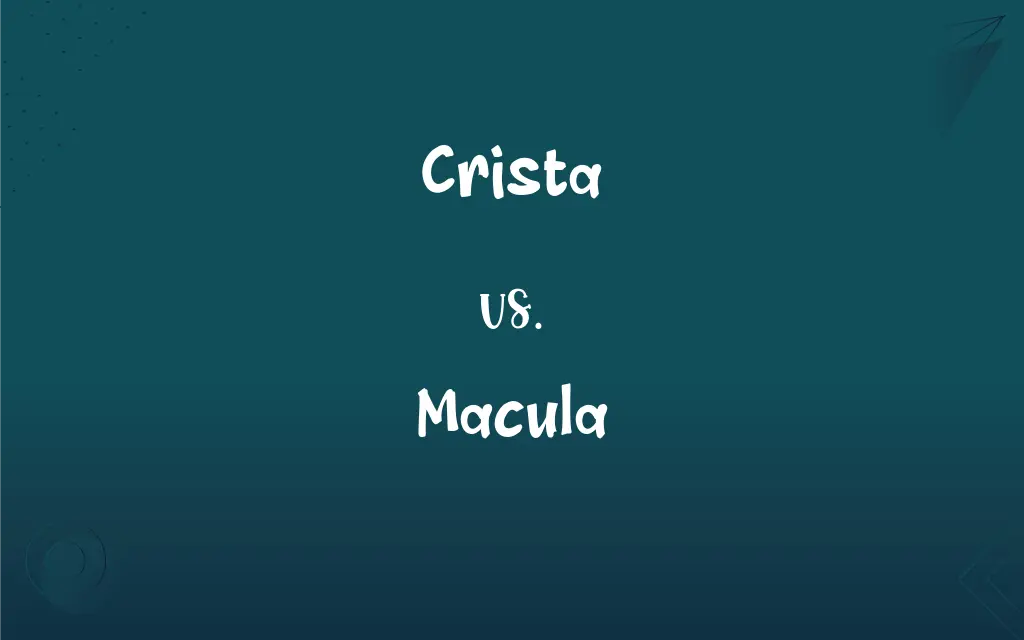Crista vs. Macula: What's the Difference?
Edited by Aimie Carlson || By Janet White || Published on February 25, 2024
Crista refers to a ridge-like structure in the inner ear involved in balance, while macula is a sensory organ in the ear for detecting linear acceleration and gravity.

Key Differences
Crista, located in the semicircular canals of the inner ear, plays a crucial role in detecting rotational movements of the head. Macula, found in the utricle and saccule, is sensitive to linear movements and gravity, helping in maintaining equilibrium.
The crista consists of hair cells and a gelatinous layer called the cupula, which moves with head rotations, activating the hair cells. In contrast, the macula comprises hair cells topped with otoliths, small crystals that respond to gravity and linear motions.
Crista functions mainly in the dynamic balance, particularly in sensing spinning or turning movements. The macula, however, is essential for static balance, helping the body understand its position in space when still.
In the functioning of the vestibular system, crista is specifically responsive to angular acceleration like turning your head. Macula, conversely, detects vertical or horizontal linear movements, such as moving forward or tilting the head.
The health and functioning of both crista and macula are vital for balance and spatial orientation. Disorders affecting either can lead to dizziness, vertigo, or balance issues, highlighting their importance in everyday movement and coordination.
ADVERTISEMENT
Comparison Chart
Location
Semicircular canals
Utricle and saccule
Function
Detects rotational movements
Senses linear acceleration and gravity
Structure
Hair cells with a cupula
Hair cells with otoliths
Role in Balance
Dynamic balance (spinning, turning)
Static balance (position in space)
Type of Movement Detected
Angular acceleration
Vertical/horizontal linear movements
ADVERTISEMENT
Crista and Macula Definitions
Crista
Crista is a ridge-like structure in the inner ear.
The crista in the semicircular canals helps with balance.
Macula
In ophthalmology, macula refers to the central part of the retina.
The macula is crucial for sharp, central vision.
Crista
Crista can also denote a prominent feature or peak.
The mountain's crista was covered in snow.
Macula
Macula is a sensory organ in the ear for detecting linear movements.
The macula helps in sensing forward motion.
Crista
In cellular biology, crista refers to the folds inside mitochondria.
The cristae increase the surface area for energy production in cells.
Macula
Macula also implies an area different in texture or color from its surroundings.
The macula on the leaf was caused by a fungal infection.
Crista
In biology, crista refers to any crest or ridge in an organism.
The crista on the bird's head is a distinctive feature.
Macula
Macula denotes a small, discolored spot or area on the skin or an organ.
The dermatologist examined the macula on her skin.
Crista
Crista is a term used in anatomy for elevated structures.
The crista galli is a bony ridge in the skull.
Macula
In biology, macula can refer to any small flat spot or patch.
The fish's body was marked with a distinctive macula.
Crista
(Anatomy) A crest or ridge, as on the top of a bone.
Macula
An opaque spot on the cornea.
Crista
(Biology) One of the inward projections or folds of the inner membrane of a mitochondrion.
Macula
The macula lutea.
Crista
(cytology) Any of the internal compartments formed by the inner membrane of a mitochondrion, where many chemical reactions take place.
Crista
(dentistry) A dental crest.
FAQs
What does the macula do?
The macula detects linear acceleration and gravity for balance.
Where is crista located?
Crista is located in the semicircular canals of the inner ear.
What is the role of the macula in balance?
Macula senses linear movements and gravity for static balance.
What happens if the crista is damaged?
Damage to the crista can lead to dizziness and balance issues.
Where can you find the macula?
Macula is found in the utricle and saccule of the inner ear.
Can crista be found in other body parts?
In anatomy, crista can refer to any ridge-like structure, not just in the ear.
Do all animals have crista and macula?
Most vertebrates have these structures for balance.
What is a crista?
A crista is a ridge-like structure in the inner ear involved in balance.
How does crista contribute to balance?
Crista detects rotational movements, aiding in dynamic balance.
Is macula unique to the ear?
No, macula can also refer to areas in the eye and on the skin.
Are crista and macula susceptible to aging?
Yes, both can degrade with age, affecting balance and coordination.
Is the crista involved in hearing?
No, its primary function is related to balance, not hearing.
Can macula damage cause vertigo?
Yes, damage to the macula can lead to vertigo and imbalance.
How are crista and macula examined medically?
Through specialized tests and imaging in audiology and otology.
Can exercises improve crista and macula function?
Vestibular rehabilitation exercises can enhance their function and balance.
Can macula disorders affect vision?
Yes, if referring to the macula in the retina, disorders can impair vision.
How do crista and macula work together?
They complement each other in providing a comprehensive sense of balance.
Does the macula help in spatial orientation?
Yes, it aids in understanding body position in space.
Are there any diseases specific to the crista?
Vestibular disorders can specifically affect the crista.
Can you see the crista and macula?
Not without special medical imaging techniques.
About Author
Written by
Janet WhiteJanet White has been an esteemed writer and blogger for Difference Wiki. Holding a Master's degree in Science and Medical Journalism from the prestigious Boston University, she has consistently demonstrated her expertise and passion for her field. When she's not immersed in her work, Janet relishes her time exercising, delving into a good book, and cherishing moments with friends and family.
Edited by
Aimie CarlsonAimie Carlson, holding a master's degree in English literature, is a fervent English language enthusiast. She lends her writing talents to Difference Wiki, a prominent website that specializes in comparisons, offering readers insightful analyses that both captivate and inform.
































































